
In response to the COVID-19 pandemic, the United States federal government and several U.S. states implemented moratoriums on eviction.

In response to the COVID-19 pandemic, the United States federal government and several U.S. states implemented moratoriums on eviction.
In March 2020, the United States Congress passed the CARES Act, which included a moratorium on the evictions of tenants in rental properties that receive federal funding or have federal government-backed mortgages until July 2020. [1]
The Centers for Disease Control and Prevention (CDC) announced an additional eviction moratorium on September 1, 2020, expected to last until December 31 of that year. [2] The order cited Section 361 of the Public Health Service Act, [lower-alpha 1] [3] which gives the agency authority to:
[...] provide for such inspection, fumigation, disinfection, sanitation, pest extermination, destruction of animals or articles found to be so infected or contaminated as to be sources of dangerous infection to human beings, and other measures, as in [the Surgeon General's] judgment may be necessary.
A challenge to the moratorium was filed in November by the Alabama Association of Realtors. In the District Court for D.C., Judge Dabney L. Friedrich ruled that the Public Health Service act did not give the CDC authority to enact moratoria on evictions. [4] Friedrich cited the rule of eiusdem generis , writing that evictions were too dissimilar from the other items listed in Section 361 to be covered under the phrase "and other measures." [5] On appeal, the Supreme Court voted 5–4, to maintain the moratorium. [6]
The Biden administration issued a new eviction moratorium on August 3, 2021, intended to last until October 3. [lower-alpha 2] [7] It was applicable to counties with substantial or high transmission rates of COVID-19. On August 26, the Supreme Court struck down the moratorium. [lower-alpha 3] [8]
43 U.S. states have implemented some form of an eviction moratorium during the COVID-19 pandemic; 27 of these states lifted their eviction moratoriums between May and September 2020. [9]
On June 28, 2021, Governor Newsom signed a bill passed by the California State Legislature extending eviction protections until September 30. [10]
In December 2020, the New York State Legislature passed a state moratorium on evictions. [11] In May 2021, the legislature extended the moratorium until August 31. [12]
The Supreme Court struck down a provision of the state moratorium that protected people who filed a form declaring economic hardship, rather than providing evidence in court. [13]

The Centers for Disease Control and Prevention (CDC) is the national public health agency of the United States. It is a United States federal agency, under the Department of Health and Human Services, and is headquartered in Atlanta, Georgia.
A debt moratorium is a delay in the payment of debts or obligations. The term is generally used to refer to acts by national governments. Moratory laws are usually passed at times of special political or commercial stress: for instance, on several occasions during the Franco-Prussian War, the French government passed moratory laws. Their international validity was discussed at length, and was upheld in the English law case Rouquette v Overman (1875) LR 10 QB. Debt moratoriums are generally opposed by creditors.

Robert Ray Redfield Jr. is an American virologist who served as the director of the Centers for Disease Control and Prevention and the administrator of the Agency for Toxic Substances and Disease Registry from 2018 to 2021.

Dabney Langhorne Friedrich is an American attorney and jurist serving as a United States district court judge of the United States District Court for the District of Columbia. She previously served as a member of the United States Sentencing Commission.

Eviction in the United States refers to the removal of tenants from the location in which they are residing. Within the United States, eviction rates vary heavily by locality. However, historically, there have been trends in domestic eviction patterns during certain time periods such as during the Great Depression and the COVID-19 pandemic.
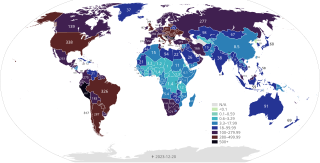
This article provides a general overview and documents the status of locations affected by the severe acute respiratory syndrome coronavirus 2 (SARS-CoV-2), the virus which causes coronavirus disease 2019 (COVID-19) and is responsible for the COVID-19 pandemic. The first human cases of COVID-19 were identified in Wuhan, the capital of the province of Hubei in China in December 2019.

The COVID-19 pandemic in the United States is a part of the worldwide pandemic of coronavirus disease 2019 (COVID-19) caused by severe acute respiratory syndrome coronavirus 2 (SARS-CoV-2). In the United States, it has resulted in 81,495,644 confirmed cases with 997,127 all-time deaths, the most of any country, and the nineteenth-highest per capita worldwide. The COVID-19 pandemic ranks first on the list of disasters in the United States by death toll; it was the third-leading cause of death in the U.S. in 2020, behind heart disease and cancer. From 2019 to 2020, U.S. life expectancy dropped by 3 years for Hispanic Americans, 2.9 years for African Americans, and 1.2 years for white Americans. These effects have persisted as U.S. deaths due to COVID-19 in 2021 exceeded those in 2020.
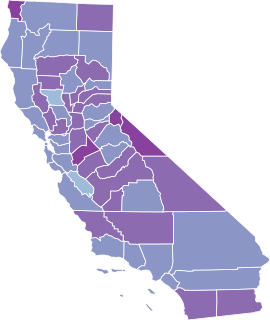
Ten of the first twenty confirmed COVID-19 cases in the United States occurred in California, the first of which was confirmed on January 26, 2020. All of the early confirmed cases were persons who had recently travelled to China, as testing was restricted to this group. On January 29, 2020, as disease containment protocols were still being developed, the U.S. Department of State evacuated 195 persons from Wuhan, China aboard a chartered flight to March Air Reserve Base in Riverside County, and in the process may have contributed to spread within the state and the US at large. On February 5, 2020, the U.S. evacuated 345 more citizens from Hubei Province to two military bases in California, Travis Air Force Base in Solano County and Marine Corps Air Station Miramar, San Diego, where they were quarantined for 14 days. A state of emergency was declared in the state on March 4, 2020, and as of February 24, 2021 remains in effect. A mandatory statewide stay-at-home order was issued on March 19, 2020, that was ended on January 25, 2021. On April 6, 2021, the state announced plans to fully reopen the economy by June 15, 2021.
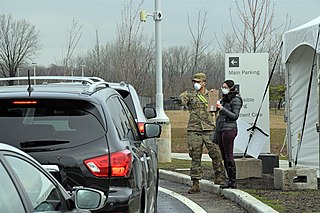
The first case of COVID-19 in the U.S. state of New York during the pandemic was confirmed on March 1, 2020, and the state quickly became an epicenter of the pandemic, with a record 12,274 new cases reported on April 4 and approximately 29,000 more deaths reported for the month of April than the same month in 2019. By April 10, New York had more confirmed cases than any country outside the US. As of February 15, 2022, the state has reported 99.1 million tests, with 4,866,986 cumulative cases, and 63,980 deaths.
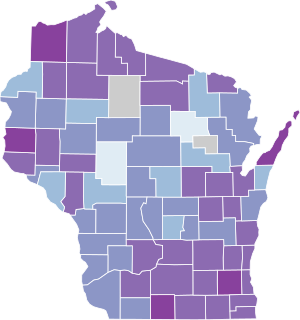
The global COVID-19 pandemic struck the U.S. state of Wisconsin in early February 2020. Although Wisconsin has to date experienced 144 deaths per 100,000 residents, significantly fewer than the US national average of 196 deaths, COVID-19 was one of the three leading causes of death in Wisconsin in 2020. On August 25, 2021, Wisconsin public health authorities reported 7 day averages of 1,417 new cases and 236 probable cases per day, an increase of greater than 15 fold since late June 2021. This brings the cumulative total of COVID-19 cases in Wisconsin to 651,338. The state's death toll is 7,558, with 30 new deaths over the previous 7 days. As of August 25, 2021, 12.41% of Wisconsin's residents have been positively diagnosed with COVID-19, the 20th highest per-capita case rate among all US states. January 16's 128 COVID-19 deaths set a new single day record for Wisconsin.
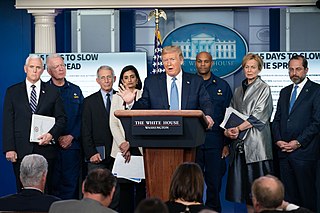
The White House Coronavirus Task Force was the United States Department of State task force during the Trump administration that "coordinate[d] and overs[aw] the administration's efforts to monitor, prevent, contain, and mitigate the spread" of coronavirus disease 2019 (COVID-19). Also referred to as the President's Coronavirus Task Force, it was established on January 29, 2020, with Secretary of Health and Human Services Alex Azar as chair. On February 26, 2020, U.S. vice president Mike Pence was named to chair the task force, and Deborah Birx was named the response coordinator.
The COVID Tracking Project was a collaborative volunteer-run effort to track the ongoing COVID-19 pandemic in the United States. It maintained a daily-updated dataset of state-level information related to the outbreak, including counts of the number of cases, tests, hospitalizations, and deaths, the racial and ethnic demographic breakdowns of cases and deaths, and cases and deaths in long-term care facilities.

Strikes occurred during the COVID-19 pandemic due to many factors including: hazard pay or low pay, unsafe working conditions, inability to pay rent. These strikes are separate from the various protests that occurred over responses to the pandemic.
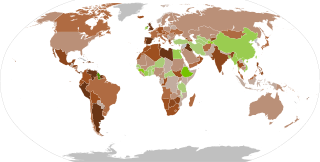
The economic impact of the COVID-19 pandemic in the United States has been widely disruptive, adversely affecting travel, financial markets, employment, shipping, and other industries. The impacts can be attributed not just to government intervention to contain the virus, but also to consumer and business behavior to reduce exposure to and spread of the virus.

The wearing of non-medical face masks in public to lessen transmission of COVID-19 in the United States was first recommended by the CDC on April 3, 2020 as supplemental to hygiene and appropriate social distancing. Over the course of the pandemic, various states, counties, and municipalities have issued health orders requiring the wearing of non-medical face coverings — such as cloth masks — in spaces and/or businesses accessible to the public, especially when physical distancing is not possible. Some areas only mandated their use by public-facing employees of businesses at first, before extending them to the general public.

The federal government of the United States initially responded to the COVID-19 pandemic in the country with various declarations of emergency, some of which led to travel and entry restrictions, and the formation of the White House Coronavirus Task Force. As the pandemic progressed in the U.S. and throughout the rest of the world, the U.S. government began issuing recommendations regarding the response by state and local governments, as well as social distancing measures and workplace hazard controls. State governments play a primary role in adopting policies to address the pandemic. Following the closure of most businesses throughout a number of U.S. states, President Donald Trump announced the mobilization of the National Guard in the most affected areas.

The COVID-19 pandemic in the United States has had far-reaching consequences in the country that go beyond the spread of the disease itself and efforts to quarantine it, including political, cultural, and social implications.

The CDC publishes official numbers of COVID-19 cases in the United States. The CDC estimates that, between February 2020 and September 2021, only 1 in 1.3 COVID-19 deaths were attributed to COVID-19. The true COVID-19 death toll in the United States would therefore be higher than official reports, as modeled by a paper published in The Lancet Regional Health – Americas. One way to estimate COVID-19 deaths that includes unconfirmed cases is to use the excess mortality, which is the overall number of deaths that exceed what would normally be expected. From March 1, 2020 through the end of 2020, there were 522,368 excess deaths in the United States, or 22.9% more deaths than would have been expected in that time period.

Rochelle Paula Walensky is an American physician-scientist who is the director of the Centers for Disease Control and Prevention and the administrator of the Agency for Toxic Substances and Disease Registry. Prior to her appointment at the CDC, she was the Chief of the Division of Infectious Diseases at Massachusetts General Hospital and a professor of medicine at Harvard Medical School. Walensky is an expert on HIV/AIDS.

COVID-19 vaccine mandates have been enacted by numerous states and municipalities in the United States, and also by private entities. In September 2021, President Joe Biden announced that the federal government would take steps to mandate COVID-19 vaccination for certain entities under the authority of the federal government or federal agencies.